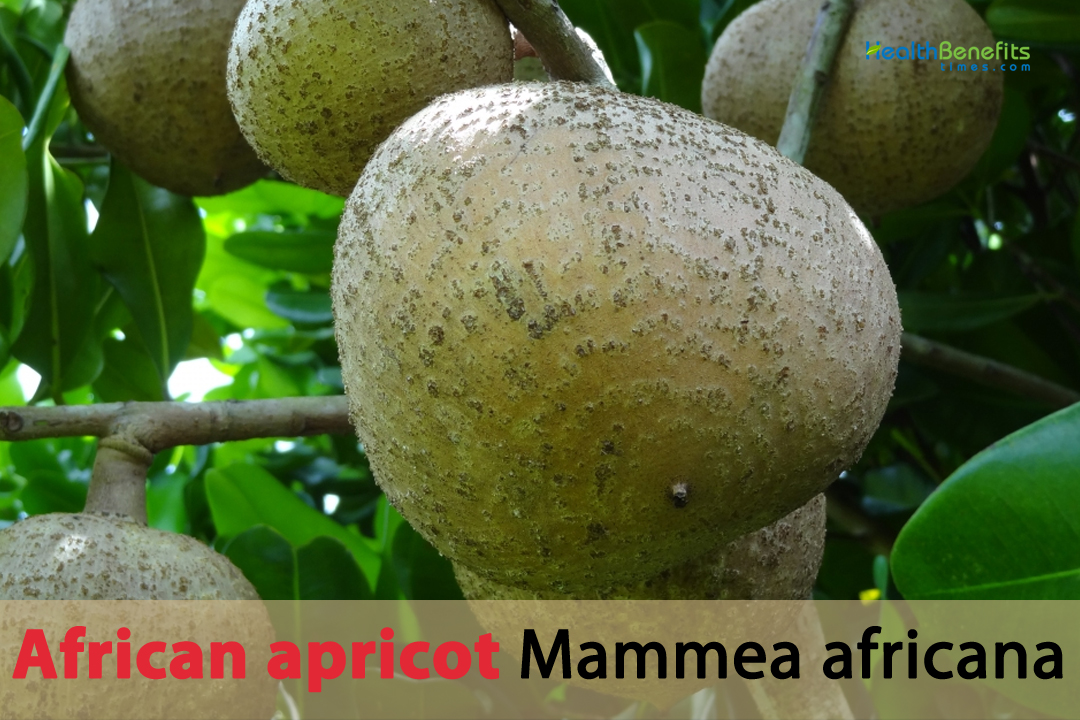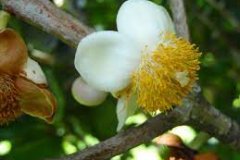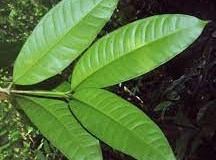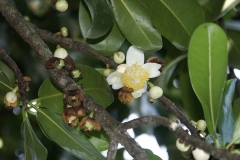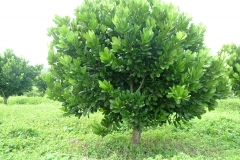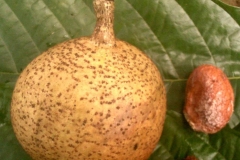Latin word “mammeus” means “producing milk” or “related to the breast,” which is where the group name “Mammea” comes from. It is possible that this name comes from the milky latex or sap that some species of the genus Mammea have. The Latin word “africanus,” which means “from Africa,” is where the name “Africana” comes from. The name of the plant tells you where it comes from, because Mammea Africana is native to warm Africa. The tree is grown for its beauty, to stop soil erosion, and as a medicine to heal cuts and skin diseases. The plant’s fruit is often picked from the wild, but it is also sometimes grown in gardens. A lot of the expensive wood is sent abroad. Oboto is the trade name for the wood that comes from this tree.
African apricot Facts
| African apricot Quick Facts | |
|---|---|
| Name: | African apricot |
| Scientific Name: | Mammea africana |
| Origin | South Africa, Kenya, Nigeria, Kenya, Cameroon, Ghana, Ivory Coast, and other West African nations |
| Colors | Green to orange-yellow when ripe |
| Shapes | Typically oval or oblong, thick drupe up to 10 cm long |
| Flesh colors | Orange to reddish-brown when ripe |
| Taste | Sweet and slightly tangy flavors with a tropical twist |
| Major nutrients | • Vitamin C • Vitamin A • Vitamin E • B Vitamins (B1, B2, B3, B5, B6) • Potassium • Calcium • Magnesium • Phosphorus • Iron • Zinc • Dietary Fiber • Carbohydrates • Healthy Facts • Antioxidants • Protein |
| Health benefits | Boosts Immune System, Heart Health, Aids Digestion, Weight Management, Healthy Skin, Oral Health, Bone Health, Regulates Blood Sugar, Aids in Wound Healing, Lowers Blood Pressure, Enhances Vision, Aids in Allergy Management, Menstrual Pain Relief, Energy Boost |
| Name | African apricot |
|---|---|
| Scientific Name | Mammea africana |
| Native | Tropical and subtropical regions of Africa, primarily found in countries such as South Africa, Kenya, Nigeria, Kenya, Cameroon, Ghana, Ivory Coast, and other West African nations |
| Common Names | Bush Mango, Gabon Plum, Wild Almond, White Star Apple, Bitter Bush Mango, Wild Mango, Bitter Kola, African Pear, African Cherry, African Plum, Gabon Nut, Dika Nut, Wild Plum, Bush Apple, African Bush Plum, African Apple, Ogbono Nut, Ogbono Plum, Nigerian Cherry, Bush Plum, Gabon Cherry |
| Name in Other Languages | Akan: Nkrakrakuma, Nkran Amharic: Gerawa, Afrika Aprīkot (አፍሪካ አፕሪኮት) Arabic: Mishmish Afriqi (مشمش أفريقي), Khârbooza Afriqiyah, Khiyar Africani (خيار أفريقي) Armenian: African zambak (Աֆրիկական զամբակ) Bambara: Gnampè, Sanjalinku Bengali: Aphrikān khōbani (আফ্রিকান খোবানি), Afrikan Kumra Bulgarian: Africanski kaisiya (Африкански кайсия), Afrikanski Rogat Krastavitsa (Африкански Рогат Краставица) Chichewa: Kachamali, Ng’ombe, Msumbiya Chibemba: Ulufuti Chinese: Fēizhōu xìngzi (非洲杏子), Fēizhōu Jiǎoguā (非洲角瓜) Croatian: African Apricot, Afrička Rogata Dinja Czech: Africký meruňkový strom Danish: Afrikansk abrikos Dutch: Afrikaanse abrikoos, Afrikaanse Hoornkomkommer English: African apricot, African mammee-apple, African-apple, Bastard-mahogany, Mamey, African Mammee Apple Estonian: Aafrika Aprikoos Ewe: Adudibi Filipino: African apricot Fon: Oshu Finnish: Afrikkalainen aprikoosi, Afrikanaprikoosi, Afrikkalainen Kurkku French: Abricot d’Afrique or Abricotier sauvage, Concombre Cornu Africain, Abricotier d’Afrique, Obota, Bokodji Georgian: Apirikuli martsquli (აფრიკული მარწყული) German: Afrikanische Aprikose, Afrikanische Horngurke Greek: Afríkanikó veríkoko (Αφρικανικό βερίκοκο), Afrikanikós Aggouri, Afrikaniki Kerasi Angouraki (Αφρικανική Κερασί Αγγουράκι) Gujarati: Africani Kakdi Hausa: Tsamiyar kurm, Afirka Zarumai Hebrew: African apricot, Kivano Afrikai (קיבאנו אפריקאי) Hindi: Afriki Khubani (अफ्रीकी खुबानी), Afriki Khira Hungarian: Afrikai sárgabarack Igbo: Udara or Agbalumo Indonesian: Aprikot Afrika Italian: Albicocca Africana, Cetriolo Africano Cornuto Japanese: Afurikanapurikotto (アフリカンアプリコット), African Horn Melon Kannada: African Tenga Kayi Kanuri: Azara Kikuyu: Thigu Kinyarwanda: Umushwaa Kirundi: Ikirara Kikongo: Kikiba Kinyamwezi: Msambi Korean: African apricot, Apeurika Oi (아프리카 오이), Afrika Horneu Melon (아프리카 호른 멜론) Latvian: Āfrikas Aprikoze Lithuanian: Afrikinis Abrikosas Lingala: Mongomongo Luganda: Emijumbwe Malagasy: Tsaramaso Malay: Aprikot Afrika Malayalam: African sarkkara (ആഫ്രിക്കൻ സര്ക്കര), African Thenga Vazha Marathi: African Kakadi Norwegian: Afrikansk aprikos, Afrikansk Agurk Oromo: Dubii Persian: Ālu yā markabāt āfrīqā (آلو یا مرکبات آفریقا) Polish: Afrykańska morela, Morela afrykańska Portuguese: Damasco-africano, Kiwano Africano Punjabi: Afriki Khira Romanian: Cais African Russian: Afrikanskiy abrikos (Африканский абрикос), Afrikanskaya Rogataya Dyunya (Африканская Рогатая Дыня) Serbian: Afrička Kajsija, Afrički Rogati Krastavac Sesotho: Mofifi Shona: Mawuyu Slovak: Africký Trnavec Uhorka Slovenian: Afriški Trnasti Kukuruznik Somali: Dabka Afrikha, Dhuxul Sotho: Aprikot ea Afrika Spanish: Albaricoque africano, Pepino Africano con Cuernos Swahili: Mpera wa Afrika, Apricoto ya Afrika Swazi: African Apricot Swedish: Afrikansk aprikos Tamil: African Thenga Vittakkai Telugu: African Nethi Beerakaya Thai: Mamwng aefrikans (มะม่วงแอฟริกัน), Taeng-khaw Fa-rang, Taeng Kieo African (แตงเขียวแอฟริกัน) Tigrinya: Gere, Girar Tswana: Mothetsi, Motheu Turkish: Afrika kayısı, Afrika Salatalığı, Afrika Kavunu Ukrainian: Afrikans’ka abrykosa (Африканська абрикоса) Urdu: Afriki Khira Vietnamese: Mơ châu Phi, Mơ Ấn Độ Châu Phi, Dưa Leo Châu Phi Wolof: Jaxatu Xhosa: Iqaba Yoruba: Kanya or Oro, Aprikọti Afirika Zarma: Sakudie Zulu: Umdlulamkhulu, Umsobo, I-aprikhoti ye-Afrika |
| Plant Growth Habit | Medium to large sized evergreen tree |
| Growing Climates | Evergreen and semi deciduous forests, understory of tropical rainforests, lowland forests, savanna woodlands, near rivers and streams, swampy or wetland areas and coastal regions |
| Soil | Prefer loamy or sandy soils that allow water to drain quickly and prevent waterlogged roots |
| Plant Size | 40 m or more tall and 1 m in trunk diameter |
| Root | Embryonic root that emerges from the seed during germination. They are typically thicker and more substantial than the secondary roots |
| Stem | Vine-like stems are long, slender, and flexible. They have a climbing or trailing growth habit, which allows them to sprawl over the ground or climb support structures |
| Leaf | Simple, coriaceous and thick, the upper surface is glossy dark green while beneath is less shiny and glabrous, the petiole is 0.4–1.5 cm long; leaf-blade is elliptical to oblong in outline, 12–26 cm long and 4–10 cm wide |
| Flowering season | November to February |
| Flower | Flower is axillary on leafy shoots and cauliflorous, with buds that are globular; pedicel is up to 4 cm long, petals are 4, white and caducous, up to 3 cm long |
| Fruit Shape & Size | Typically oval or oblong thick drupe up to 10 cm long |
| Fruit Color | Green to orange-yellow when ripe |
| Fruit Skin | Rough, scaly, leathery texture |
| Flesh Color | Usually orange to reddish-brown when ripe |
| Fruit Weight | Between 10 to 50 grams (0.35 to 1.76 ounces) |
| Seed | Small, elongated, and oval or oblong in shape. They can be up to 65.7mm (2.6 inches) long and 48.7mm (1.9 inches) in thickness |
| Flavor/Aroma | Delightful blend of fruity and sweet notes |
| Taste | Sweet and slightly tangy flavors with a tropical twist |
| Plant Parts Used | Leaves, Bark, fruit pulp, seed oil, roots |
| Propagation | By seed, stem cutting, grafting |
| Lifespan | Approximately 50 to 70 years or more when well-maintained and grown in favorable conditions |
| Season | April to July |
| Major Nutrition |
|
| Available Forms |
|
| Health benefits |
|
Plant Description
The African apricot tree is a medium to big evergreen with a small, dense crown and short, spreading branches. It can grow to be 45 meters tall in its full height. The straight, cylinder-shaped bole can be up to 27 meters long and up to 125 cm wide without any branches. At the base, it can have big root bumps or steep buttresses that are up to 3.5 meters high. The plant grows in lowland forests, savanna woods, near rivers and streams, swampy or wetland areas, coastal regions, and forests that don’t lose their leaves for a long time. The plant does best in sandy or loamy soils that drain water quickly and keep roots from getting too wet.
The people in the area use this tree for many useful things, like food, medicine, and other goods. Plant parts from this species are used to treat fevers, stomachaches, and skin diseases like scabies. Wood is used for joinery, piling, and woodworking in the area. People in the area eat the fruit, even though it is tough. In small streams, the bark is used to harm fish, but it’s not very strong.
Appropriate growing environment for African apricot
African apricot thrives in specific growing conditions. Here is an overview of the appropriate growing environment for African apricots
- Climate: The African peach is a tropical or subtropical plant. They do best where it is warm, doesn’t freeze, and there is lots of sunshine. For best growth, they need temperatures between 70°F (21°C) and 85°F (29°C). Because they are sensitive to cold, don’t put them in places below 50°F (10°C) or where it frosts.
- Sunlight: African peaches like to be in the sun. To do well, they need to be in full sun, which means they should get at least 6 to 8 hours of straight sunlight every day. Place them somewhere where they will get a lot of sunshine during the growing season.
- Soil: For African apricots to grow, the dirt must drain well. They like soft or loamy soils that drain water quickly and keep roots from getting too wet. If you want healthy plants, the pH of your soil should be between 6.0 and 7.0. Adding organic matter to the soil, like compost, can make it more fertile and help water run away.
- Watering: African apricots need steady moisture, but root rot can happen if the soil stays too wet for too long. When you water, be sure to water fully and evenly, and let the soil dry out a bit between times. During dry times or droughts, you should water your plants more often to make sure they get enough water.
- Spacing: Leave a lot of space between African apricot seeds or seedlings when you put them. Each plant needs enough space for its branches to grow and spread out, since they grow in a trailing fashion. Leave at least 3 to 4 feet between them so they can grow properly.
- Support Structures: African apricots grow like vines and need support structures like fences or trellises. These things help keep the vines off the ground, which lowers the risk of disease and makes it easier to pick the fruit.
- Fertilization: Follow the directions on the package to use a balanced, all-purpose fertilizer on African apricot trees. Don’t use too much nitrogen fertilizer, as it can cause leaves to grow too quickly and stop fruit production.
- Pruning: African apricot plants can be kept in check by pruning them on a regular basis. This also helps the plants breathe, which lowers their risk of getting illnesses. Cut off any dead or sickly growth and spread out vines that are getting too crowded.
- Pest and Disease Management: To protect your African apricot plants from common bugs and illnesses like aphids, spider mites, and fungal diseases, keep an eye out for them. As needed, protect the plants with the right organic or chemical measures.
- Harvesting: Most of the time, African apricots are picked when they are completely ripe. When the fruit is ready, the rough skin turns orange-yellow and the flesh gives a little when lightly pressed. The fruit is picked by cutting it off the bush.
Roots
The radicle is the embryonic root that comes out of the seed when it sprouts. It is from this that the main roots grow. These main roots go deep into the ground to hold the plant in place and take in water and food. Most of the time, they are larger and stronger than the secondary roots. The main roots send out secondary roots, which are also called lateral roots or branching roots. The main roots send out these secondary roots that spread out horizontally through the dirt in search of water and food. A very important part of their job is to help the plant take in more nutrients from the dirt.
Very small structures that look like hairs grow on the surface of the secondary roots. These are called root hairs. These root hairs make the root system’s surface area much bigger, which makes it easier for the plant to take in water and nutrients from the dirt. Root hairs are very important for plants because they help them take in important substances. Active cell division takes place at the growing tips of the roots. As the root tips get longer, they go deeper into the ground to find food and water. The plant’s root tips are very sensitive to their surroundings and help it move through the dirt. At the very end of the root is a defensive structure called the root cap. It protects the root tip’s tiny cells that are growing quickly. The root cap protects the root as it pushes through the dirt and looks for problems or changes in the soil.
Stem
The stems of African apricot trees are long, thin, and bendy, making them look like vines. They grow either climbing or trailing, which lets them spread out on the ground or climb things like trellises for support. The coiled tendrils that grow along the roots are one thing that makes it stand out. These stem-like extensions are like climbing organs that help the plant hold on to close things or structures. Some roots have been changed so that they can coil around a support and help the plant grow upward. The stems have vascular tubes that carry water, nutrients, and sugars throughout the plant, just like most plant stems. These bundles are made up of xylem, which moves water and minerals from the roots to the leaves, and phloem, which moves sugars made by photosynthesis to the leaves.
There are special parts along the stem called tendril buds. As new branches grow from these buds, they help the plant keep growing up or down or along a path. Along the stems of some types, there may be small thorns or prickles. Plants have these thorns to protect themselves from animals that might try to eat them. The stems are usually green or greenish-brown, but they can be any color. This is normal for plants that get their energy from photosynthesis.
Leaves
Most leaves are palmate, which means they have many lobes that spread out from a center point, making the shape of a hand or palm. The amount of lobes can be different, but most of the time there are five to seven of them. There are smaller lobes or pieces that can be made from each lobe. Along the stem, the leaves are grouped in pairs. That is, one leaf is attached at a node, and the next leaf is attached at a different spot on the stem, going back and forth between the sides. Most leaf edges are serrated, which means they have small, sharp teeth or grooves along the lobes. The size and width of these grooves can change. The leaves can be different sizes, but most of the time they are medium-sized. Photosynthesis, the process by which plants make energy, needs a lot of surface area, which the leaves provide.
The leaves of an African apricot tree are usually green, which is normal for leaves that have chlorophyll, the pigment that makes photosynthesis possible. For plants, the green color means that chlorophyll is present and that they can use sunshine for energy. Veins run through the leaves and carry water, nutrients, and sugars to different parts of the leaf. You can see these lines on both the top and bottom of the leaf. The outside of leaves is mostly smooth, but they can feel a little slippery when you touch them. Leaf stalks, also called petioles, connect each leaf to the stem. The petiole is what connects the leaf to the plant and helps it stand up so that it gets the most sunlight. The leaves are thin and bendy, which is normal for leaves of many plants in the cucumber family.
Flowers
Each plant only makes one type of flower, so each flower is either male or female. This trait is common in cucurbit plants, which need to be cross-pollinated in order for fruit to grow. The flowers of the African peach are usually small and not very noticeable. They look like tubes or bells, and their five petals are joined together to make a corolla. Flowers can be any color, but most of the time they are yellow or yellowish green. It is possible for the same African apricot plant to have both male and female flowers. Most of the time, the male flowers are grouped together on long, thin stalks. Each male flower has a tube-shaped bloom with five petals and a column-shaped structure in the middle called a stamen. The female flowers usually grow alone and on shorter stalks. The female flower also has a tube-shaped corolla with five petals, but the pistil, which is the female reproductive part, is inside it.
Fruits
The outermost layer of the fruit is characterized by its spiky, horned appearance. If the fruit is ready, the skin will be orange-yellow. The spikey parts are soft and bendable, so you can touch them without getting hurt. Inside the fruit, the skin acts as a shield to keep the inside safe. The skin of the fruit has spikes on it. The part you can eat is called the meat or pulp. Most of the time, the skin is bright green and feels like gel. It is made up of cells that are filled with a clear, jelly-like material. The African apricot’s meat is juicy and has small seeds that you can eat. Depending on how ripe the fruit is, the meat can taste either slightly sweet or slightly sour.
Seeds
The seeds of African apricots are usually small, long, and oval or oblong in shape. The outside of them is smooth and pretty hard. Most of the time, the seeds’ shells are white or cream-colored. The color can be a little different based on things like how ripe the fruit is and how it was grown. Although seeds come in a range of sizes, most are small, measuring between 0.4 and 0.8 inches in length. The seeds have an outer shell, an inner seed coat, and an embryo.
Health benefits of African apricot
African apricot offers several health benefits. Here are some of the detailed health benefits of African apricot:
1. Rich in Antioxidants
The African apricot is full of phytochemicals and antioxidants like vitamin C and vitamin A. These antioxidants help keep your cells safe from the damage that free radicals do, which lowers your risk of getting chronic diseases like cancer.
2. Boosts Immune System
The African apricot’s high vitamin C level is a key part of making the immune system stronger. It helps your body make more white blood cells, which makes it better able to fight off infections and sicknesses.
3. Supports Heart Health
African apricot has potassium, which helps keep blood pressure in check and lowers the risk of hypertension. In addition, it helps the heart work right and lowers the risk of heart illnesses.
4. Aids Digestion
The fiber in African apricots helps the digestive system. It helps you have normal bowel movements, keeps you from getting constipated, and keeps your digestive system healthy.
5. Weight Management
Fiber intake makes you feel full, which makes you less likely to eat too much. This can help you keep your weight in check and lose weight.
6. Healthy Skin
Collagen production depends on vitamin C, which is important for keeping skin healthy and looking young. African apricot has antioxidants that help protect the skin from smog and UV rays.
7. Oral Health
People think that chewing the skin of an African apricot will help keep your teeth healthy. Some people say it can help keep your teeth healthy and your breath fresh.
8. Bone Health
African apricot has calcium in it, which helps keep bones and teeth strong. Getting enough calcium can help keep your bones healthy and prevent osteoporosis.
9. Anti-Inflammatory Properties
Some of the chemicals in African apricot can help reduce inflammation. These can help lower inflammation in the body and ease the pain of inflammatory diseases like arthritis.
10. Regulates Blood Sugar
According to research, African apricot may help keep blood sugar levels in check. This means that it might be good for people who already have diabetes or are at risk of getting it.
11. Aids in Wound Healing
It has a lot of vitamin C, which helps the body heal wounds naturally. It helps collagen form, which is important for healing tissues.
12. Reduces the Risk of Chronic Diseases
Bioactive compounds like polyphenols and flavonoids are found in large amounts in African apricots. These compounds have been linked to a lower chance of chronic diseases like heart disease, diabetes, and some cancers. These chemicals can protect cells from damage and inflammation because they are antioxidants and anti-inflammatory.
13. Lowers Blood Pressure
Potassium, which is found in African apricot, is very important for keeping blood pressure in check. Getting enough potassium can help relax the walls of your blood vessels, which lowers your risk of high blood pressure and improves your general heart health.
14. Enhances Vision
African apricots have a lot of vitamin A, which is important for keeping your eyes healthy. Vitamin A is good for your eyes, keeps you from going blind at night, and may lower your risk of age-related macular degeneration.
15. Natural Diuretic
African apricot is naturally a diuretic, which means it can help the body get rid of extra salts and toxins by making more pee. This may help people with edema (fluid buildup) and may be good for the health of their kidneys.
16. Aids in Allergy Management
Some people say that eating African apricot may help ease allergy symptoms, especially those that are linked to breathing allergies. Its anti-inflammatory properties are what cause this result.
17. Supports Brain Health
African apricots contain antioxidants, such as vitamin C, that protect brain cells from toxic stress. This may lower the risk of neurodegenerative diseases like Parkinson’s and Alzheimer’s.
18. Pregnancy Support
Folate, or vitamin B9, is found in large amounts in African apricots. Folate is very important for pregnant women. A healthy fetal growth can help prevent birth defects and make sure the fetus gets enough folate.
19. Boosts Collagen Production
In African apricots, vitamin C helps the body make collagen, which makes skin more flexible and less noticeable wrinkles and fine lines.
20. Anti-Aging Properties
The antioxidants in the fruit may help slow down aging by protecting skin from free radicals and UV rays. This could make skin look better and younger.
21. Menstrual Pain Relief
African apricot is used to ease the pain and discomfort of menstruation in some traditional African health systems.
22. Gut Health
African apricots have dietary fiber that can help keep your gut healthy by supporting good bacteria. This can make digestion and gut health better overall.
23. Energy Boost
The natural carbs in the fruit, along with its other nutrients, can give you a quick energy boost.
Culinary uses of African apricot
The African apricot is a unique and exotic fruit with a spiky, orange-yellow skin and bright green, jelly-like flesh. While it’s not as commonly found as some other fruits, it has a distinct flavor and several culinary uses:
- Fresh Consumption: There is an easy way to enjoy an African apricot: cut it in half and use a spoon to remove the green, seeded meat. It tastes a bit like a mix of cucumber, kiwi, and banana. It’s slightly sweet and slightly sour.
- Salads: You can add sliced or diced African apricot to salads to make them taste fresh and different. It goes well with many kinds of greens, veggies, and dressings because of its crunchy texture and unique flavor.
- Salsas: Cut the African apricot into small pieces and add them to salsas. It tastes sweet and sour with a bit of heat when mixed with tomatoes, onions, cilantro, lime juice, and a little chili.
- Smoothies: The African apricot’s flesh can be mixed with bananas, pineapples, or mangoes to make a drink with a tropical taste. You can make it creamier by adding yogurt or coconut milk.
- Cocktails: After you puree the fruit, you can add it to drinks or mock tails. Drinks like margaritas and tropical punches can get a new taste and color from it.
- Chutneys: The African apricot can be used to make jams or chutneys. It makes a tasty sauce when mixed with sugar, vinegar, spices, and onions. It goes well with grilled meats, fish, or as a sandwich filling.
- Desserts: For a cool and tropical treat, add the fruit to sweets like fruit salads, sorbets, or ice creams. It can also be used to make a fruit pie or a special kind of fruit parfait.
- Garnish: African apricot slices or wedges can be used to decorate a wide range of foods, from seafood platters to fruit salads and even sweets.
- Ceviche: Ceviche is an African dish where seafood is “cooked” in citrus juices. The meat of the African apricot is used in this dish. The fruit’s unique taste and texture can make this dish more interesting.
- Jellies and Preserves: Because it naturally has a gel-like texture, African apricot can be used to make jams, jellies, or sauce. It makes a tasty spread when mixed with sugar and lemon juice.
- Sorbet: If you blend African apricots together, you can make a cool smoothie. Fruit puree, sugar, water, and a little lemon juice should all be mixed together and then frozen for a tasty frozen treat.
- Fruit Cocktails: Diced African apricot and tropical fruits like pineapple, mango, and papaya can be mixed together to make a tasty fruit drink. For a spicy-sweet twist, you can drizzle it with honey or sprinkle it with chili powder.
- Fruit Sushi: Instead of seaweed in fruit sushi, use thin strips of African apricot to make a unique dessert. Put sticky rice and fruit slices, like strawberry or kiwi, around it and roll it up. Then, wrap it in plastic wrap. Cut it up into small pieces and serve it with honey and soy sauce dipping sauce.
- Savory Dishes: African apricot is usually used in sweet recipes, but you can also try it in savory ones. To add a taste of sweetness and sourness to marinades for meats, poultry, or seafood, diced or pureed fruit could be added.
- Infused Water: You can make a delicious drink with water or homemade lemonade by adding slices of African apricot. It can make your drinks taste better without being too sweet.
- Fruit Leather: You can make a delicious drink with water or homemade lemonade by adding slices of African apricot. It can make your drinks taste better without being too sweet.
- Chilled Soups: To make chilled drinks like gazpacho or cucumber soup taste and feel different, add African apricot. For a cool summer drink, blend it with yogurt, cucumber, herbs, and spices.
- Fruit Skewers: For bright and tasty fruit skewers, put pieces of African apricot on skewers with other fruits like melons, berries, and grapes. You can use them as a starter or a healthy snack.
- Tropical Toppings: If you want a tropical breakfast treat, put diced African apricot, shredded coconut, and honey on top of pancakes, waffles, or cereal.
- Fruit Popsicles: Freeze blended African apricots with coconut milk or fruit juice in Popsicle shapes to make your own frozen treats. They’re a fun and good snack for the summer.
Different uses of African apricot
Certainly, here are different uses for African apricot:
- Skin and Hair Care: The seeds of the African apricot are used to make oil, which is high in antioxidants and often found in skin care items. It can keep your skin wet, slow down the aging process, and make your skin and hair healthier in general. For natural skin care, massage oil, or hair conditioning, you can use it.
- Ornamental Plant: The fruit of the African apricot is valuable, but the plant is also pretty to look at. It looks interesting in parks and landscapes because its orange-yellow skin is spiked and its flesh is bright green.
- Livestock Feed: African apricots are sometimes fed to animals in some places. People and animals can eat the plant’s leaves and vines, which makes it a useful resource for farming.
- Natural Dye: The African apricot’s skin has natural dyes that can be used to color fabrics and other materials. The bright orange color can be taken out and used to color other things.
- Crafts and Decorations: A lot of people use the fruit for crafts and decorations because it looks different and has bright skin. Many times, African apricots are used to make wreaths, centerpieces, and other artistic things.
- Soap and Candle Making: A lot of people make their own soap and candles with African apricot oil. It gives these items a natural scent and makes them more moisturizing.
- Insect Repellent: In some places, the fruit and leaves of the African apricot are used to keep bugs away. You can burn the leaves to make smoke that keeps bugs away, and you can put the fruit around your home to do the same thing.
- Traditional Rituals: In some African societies, the African apricot may be used in rituals or as a sign. As a gift or decoration, it can be used in ceremonies, festivals, or traditional practices.
- Food for Wildlife: In its natural environment, the African peach is food for many kinds of animals. Animals and birds eat the fruit’s seeds and flesh, which is good for the environment.
- Traditional Music Instruments: It is common for people in some parts of Africa to use the dried gourds of the African apricot tree to make traditional singing instruments like lutes and maracas. In traditional music, the dried shells can be cut out and filled with seeds, beads, or other things to make rhythmic sounds.
- Natural Exfoliant: The African apricot seeds can be dried, then ground into a fine powder. This powder can then be added to skin care items to help remove dead skin cells. It can help get rid of dead skin cells and make skin better when mixed with other things.
- Animal Enclosures: The African apricot’s tough, spiky skin can be used as a fence around animals or as a safe barrier. Animals won’t go into certain places because it scares them away.
- Traditional Crafts: African apricot gourd shells that have been dried out are often carved or painted to make traditional crafts and works of art. In some places, these decorative things may have artistic or cultural meanings.
- Natural Birdhouses: African apricot gourds that have been hollowed out can be used as natural birdhouses. They are good for the environment because they give birds a place to live.
- Educational Tools: You can use the African apricot to teach about different plant species, biodiversity, and how to use natural resources in a way that doesn’t harm the environment in nature centers or schools.
- Sculpture Material: The gourd shells and vines of the African apricot can be used by artists as modeling materials to make one-of-a-kind works of art.
- Traditional Medicine Containers: The dried African apricot gourds are used to store traditional medicines or herbs in some countries. People think that they have natural qualities that can make the medicines inside work better.
- Firewood and Charcoal: African apricot vines and twigs that have been dried out can be used as firewood or turned into charcoal for cooking and heating.
- Natural Potpourri: Apricot gourd shells that have been dried out and left empty can be filled with fragrant herbs, spices, or flowers to make natural potpourri. You can hang them up or put them somewhere inside to add a scent.
Side effects of African apricot
African apricot is generally considered safe to eat when consumed in moderation. However, like many foods, it may have side effects or potential allergenic reactions in some individuals. Here are some possible side effects and considerations associated with African apricot consumption:
- Allergic Reactions: Some people might be allergic to the African apricot or other fruits in the same family as cucumbers (Cucurbitaceae). Some allergic responses are mild, like itching or hives, and some are very bad, like anaphylaxis or trouble breathing. If you are allergic to cucumbers or fruits that are similar, you should stay away from African apricot.
- Digestive Issues: Some people may find it hard to eat African apricot because it tastes and feels different from other fruits. It may be different from what most people are used to eating because it has seeds and a jelly-like pulp. If you eat too much, you might get stomach problems like bloating or diarrhea.
- Oxalate Content: Oxalates are naturally occurring chemicals that can be found in many fruits and veggies, including the African apricot. For some people, eating a lot of oxalates may make kidney stones more likely to form. If you often get kidney stones, you should limit how much African apricot you eat and drink a lot of water to help flush out the oxalates.
- High Potassium: The African apricot has a fair amount of potassium, which is usually a good thing for you. Some people should watch how much potassium they take in, though, especially if they have kidney problems or are taking medicines that change their potassium levels.
- Blood Sugar Impact: African apricot doesn’t have a lot of sugar, but people with diabetes should still check their blood sugar levels when they eat foods, like African apricot. It’s best to eat it in moderation and as part of a healthy diet.
- Cross-Contamination: African apricots can get bugs like Salmonella or E. coli on them when they are cut or handled. To lower the risk of getting sick from food, it’s important to wash the fruit well and follow good food cleanliness.
- Pregnancy and Breastfeeding: Women who are pregnant or nursing should be careful when adding new foods to their diet. African apricot is one of those foods. Since there isn’t a lot of information out there, it’s usually best to use it in moderation and talk to a doctor if you have any worries.
References:
https://www.itis.gov/servlet/SingleRpt/SingleRpt?search_topic=TSN&search_value=506122#null
https://tropical.theferns.info/viewtropical.php?id=Mammea+africana
https://plants.usda.gov/home/classification/68559
https://en.wikipedia.org/wiki/Mammea_africana
https://apps.worldagroforestry.org/treedb/AFTPDFS/Mammea_africana.PDF
https://plants.usda.gov/home/plantProfile?symbol=MAAF2


